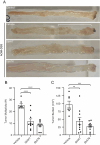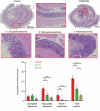Engineered spermidine-secreting Saccharomyces boulardii ameliorates colitis and colon cancer in mice
- PMID: 40885775
- PMCID: PMC12398581
- DOI: 10.1038/s41598-025-16736-5
Engineered spermidine-secreting Saccharomyces boulardii ameliorates colitis and colon cancer in mice
Abstract
Experimental studies suggest that the probiotic yeast Saccharomyces boulardii can mitigate the symptoms of inflammatory bowel disease. However, these results are equivocal and S. boulardii probiotic therapy has not gained widespread acceptance in clinical practice. To assess whether the therapeutic properties of S. boulardii might be improved upon, we engineered S. boulardii to overproduce and secrete spermidine, a pro-regenerative natural metabolite. We employed CRISPR gene deletion and integration of gene cassettes at the Ty2 locus to achieve high level polyamine synthesis and transport. We tested whether spermidine secreting S. boulardii could reduce disease symptoms in dextran sulfate sodium (DSS) and azoxymethane induced models of intestinal inflammation and cancer. We demonstrate that oral delivery of spermidine-secreting S. boulardii in mice populates the gastrointestinal tract with viable spermidine-secreting S. boulardii cells and raises free spermidine levels in the gastrointestinal tract. Strikingly, spermidine-secreting S. boulardii strains were significantly more effective than wild-type S. boulardii in reducing colitis symptoms as well as colitis-associated carcinogenesis in mice. These results suggest that in situ spermidine secretion by engineered synthetic biotic yeast strains may be an effective and low-cost therapy to mitigate inflammatory bowel disease and associated colon cancer.
Keywords: S. boulardii; Colitis; Colon cancer; Inflammatory bowel disease; Spermidine.
© 2025. The Author(s).
Conflict of interest statement
Declarations. Competing interests: The authors declare no competing interests.
Figures






Similar articles
-
Engineered Probiotic Saccharomyces boulardii Reduces Colitis-Associated Colorectal Cancer Burden in Mice.Dig Dis Sci. 2025 Jul;70(7):2348-2367. doi: 10.1007/s10620-025-09008-9. Epub 2025 Mar 29. Dig Dis Sci. 2025. PMID: 40156662 Free PMC article.
-
Optimized Mouse Model to Induce Colitis-Associated Colon Cancer using Azoxymethane and Dextran Sulfate Sodium for Tumor Immunology and Therapy Studies.J Vis Exp. 2025 Jul 25;(221). doi: 10.3791/68351. J Vis Exp. 2025. PMID: 40788861
-
The effects of candidate probiotic strains on the gut environment in dextran sulfate sodium-induced colitis mouse.Sci Rep. 2025 Jul 1;15(1):21103. doi: 10.1038/s41598-025-03860-5. Sci Rep. 2025. PMID: 40593990 Free PMC article.
-
Genetic engineering of Saccharomyces boulardii: Tools, strategies and advances for enhanced probiotic and therapeutic applications.Biotechnol Adv. 2025 Jul 30;84:108663. doi: 10.1016/j.biotechadv.2025.108663. Online ahead of print. Biotechnol Adv. 2025. PMID: 40750061 Review.
-
The Role of Genetically Engineered Probiotics for Treatment of Inflammatory Bowel Disease: A Systematic Review.Nutrients. 2023 Mar 24;15(7):1566. doi: 10.3390/nu15071566. Nutrients. 2023. PMID: 37049407 Free PMC article.
References
-
- Verdon, C. et al. No change in surgical and hospitalization trends despite higher exposure to Anti-Tumor necrosis factor in inflammatory bowel disease in the Quebec provincial database from 1996 to 2015. Inflamm. Bowel Dis.27, 655–661 (2021). - PubMed
-
- Ng, S. C. et al. Worldwide incidence and prevalence of inflammatory bowel disease in the 21st century: a systematic review of population-based studies. Lancet390, 2769–2778 (2017). - PubMed
-
- Nishida, A. et al. Gut microbiota in the pathogenesis of inflammatory bowel disease. Clin. J. Gastroenterol.11, 1–10 (2018). - PubMed
MeSH terms
Substances
Grants and funding
LinkOut - more resources
Full Text Sources

